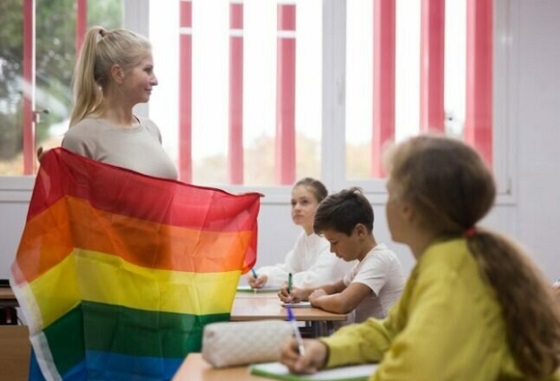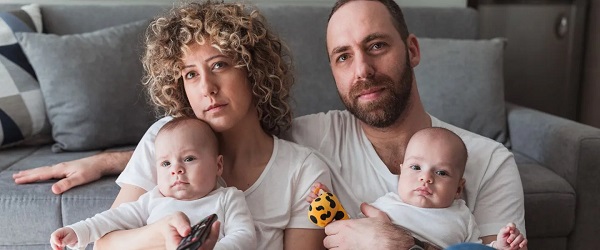Education
Toronto-area Catholic school hid ‘trans’ identity of 10-year-old girl from her parents

From LifeSiteNews
A school in the York Catholic District School Board kept ten-year-old Julie’s ‘transition’ a secret from her parents and called the Children’s Aid Society when her parents questioned what was happening with their daughter. The girl has since detransitioned.
A Toronto-area Catholic school has been exposed for hiding a young girl’s “gender transition” from her parents, and calling the Children’s Aid Society on the family when the parents expressed concern over the decision.
In a September 3 article, the National Post revealed that an unnamed school in the York Catholic District School Board (YCDSB), located in the suburbs of Toronto, kept a ten-year-old girl’s “transition” a secret from her parents and called the Children’s Aid Society (CAS) when her parents questioned what was happening. The National Post article uses the alias “Julie” for the girl for privacy reasons, it also uses aliases for the names of the parents.
“Transgender activists were actively posting videos about ‘safe’ breast binding and how euphoric testosterone makes you feel and how it makes all your problems suddenly disappear. The more I was brainwashed by these videos, the more I started to resonate with them,” Julie, who is now thirteen and no longer thinks she is “transgender,” told the outlet.
The article retells Julie’s experience, relaying that her gender dysphoria began in 2021 when she installed social media app TikTok and spent hours on it during COVID lockdowns. While online, Julie fell down rabbit holes and “discovered the LGBTQ+ community.”
In 2021, at the start of her grade five year, after watching a video asking viewers whether they were “anxious and uncomfortable” in their own bodies, Julie became convinced she was “non-binary.”
In 2022, she came out to her class and began using “they/them” pronouns and a male name with the help of a teacher from the YCDSB. This development was kept from her parents who only discovered it in June 2022 when Julie began cutting her hair short and revealed that she did not feel “like a girl anymore.”
“It was a horrible time for me as a parent because so much was happening behind my back. I didn’t know for a long while about many things that were happening. I suspected that something was really wrong,” Julie’s mother, Christina, recalled to the National Post.
Many Ontario school boards have policies requiring teachers and staff withhold students’ private information from their parents, including the York Region District School Board, Thames Valley District School Board, and the Hamilton-Wentworth District School Board.
By the beginning of grade six, in September 2022, Julie believed she was a boy, using a male name and looking into testosterone injections and a double mastectomy.
Julie also began wearing a chest binder, which led to a fight with her parents who worried about its long-term effects, especially as it had already caused bruising. Shortly after, Julie ran away from home and was later hospitalized with the intent to self-harm.
However, instead of addressing Julie’s underlying phycological issues, doctors assured her that chest binding was safe and even asked if she would like to learn about puberty blockers.
“At that age, I can’t make a conscious decision about medical interventions with an extremely high risk of life-threatening side effects that could make me unable to ever conceive a child,” Julie declared. “All accepted that I’m a boy and never tried to dig up any underlying problems that might be causing these suicidal ideations.”
After Julie ran away, the school called CAS, claiming that Christina’s opposition to Julie’s transition is a potential “culprit of conflict.” Over the next few months, the school called CAS several times, leading the agency to visit the family in their home at least five times.
The school principal told CAS that “she knows that the family loves their child and want the best for the child but they are doing a lot of damage emotionally at this time.”
Finally, in the early months of grade seven, now aged twelve, Julie’s father brought home Irreversible Damage by Abigail Shrier, which discussed the reasons behind gender dysphoria. While her father had bought the book for himself, Julie read it out of curiosity.
“After reading about detransitioners and how they came to identify as transgender, I understood I was heading in the wrong direction and needed to turn around before I hurt my loved ones or myself,” she revealed.
This began Julie’s detransition journey, which she discovered was not as celebrated as her initial decision to identify as a boy.
“When we announced that she wants to go back to female pronouns, everyone kept asking: ‘Are you sure? Are you sure you want to transition?’” Christina said.
Similarly, Julie revealed, “I did not really lose any friends, but my closest friends seem to be, pushing away from me. Like, they’re not talking to me as much, and they’re part of the LGBTQ” community.”
Now, as she enters grade eight, Julie revealed that she “finally felt truly at peace with my identity.”
Unfortunately, Julie’s story is not unique.
As LifeSiteNews previously reported, many Ontario parents revealed that public schools did not ask for parental consent before “gender transitioning” their children, resulting in child-parent relationships being destroyed.
Despite the claims of LGBT activists, a significant body of evidence shows that “affirming” gender confusion carries serious harms, especially when done with impressionable children who lack the mental development, emotional maturity, and life experience to consider the long-term ramifications of the decisions being pushed on them, or full knowledge about the long-term effects of life-altering, physically transformative, and often irreversible surgical and chemical procedures.
Studies find that more than 80 percent of children suffering gender dysphoria outgrow it on their own by late adolescence and that “transition” procedures, including “reassignment” surgery, fail to resolve gender-confused individuals’ heightened tendency to engage in self-harm and suicide – and even exacerbate it, including by reinforcing their confusion and neglecting the actual root causes of their mental strife.
Alberta
Schools should go back to basics to mitigate effects of AI

From the Fraser Institute
Odds are, you can’t tell whether this sentence was written by AI. Schools across Canada face the same problem. And happily, some are finding simple solutions.
Manitoba’s Division Scolaire Franco-Manitobaine recently issued new guidelines for teachers, to only assign optional homework and reading in grades Kindergarten to six, and limit homework in grades seven to 12. The reason? The proliferation of generative artificial intelligence (AI) chatbots such as ChatGPT make it very difficult for teachers, juggling a heavy workload, to discern genuine student work from AI-generated text. In fact, according to Division superintendent Alain Laberge, “Most of the [after-school assignment] submissions, we find, are coming from AI, to be quite honest.”
This problem isn’t limited to Manitoba, of course.
Two provincial doors down, in Alberta, new data analysis revealed that high school report card grades are rising while scores on provincewide assessments are not—particularly since 2022, the year ChatGPT was released. Report cards account for take-home work, while standardized tests are written in person, in the presence of teaching staff.
Specifically, from 2016 to 2019, the average standardized test score in Alberta across a range of subjects was 64 while the report card grade was 73.3—or 9.3 percentage points higher). From 2022 and 2024, the gap increased to 12.5 percentage points. (Data for 2020 and 2021 are unavailable due to COVID school closures.)
In lieu of take-home work, the Division Scolaire Franco-Manitobaine recommends nightly reading for students, which is a great idea. Having students read nightly doesn’t cost schools a dime but it’s strongly associated with improving academic outcomes.
According to a Programme for International Student Assessment (PISA) analysis of 174,000 student scores across 32 countries, the connection between daily reading and literacy was “moderately strong and meaningful,” and reading engagement affects reading achievement more than the socioeconomic status, gender or family structure of students.
All of this points to an undeniable shift in education—that is, teachers are losing a once-valuable tool (homework) and shifting more work back into the classroom. And while new technologies will continue to change the education landscape in heretofore unknown ways, one time-tested winning strategy is to go back to basics.
And some of “the basics” have slipped rapidly away. Some college students in elite universities arrive on campus never having read an entire book. Many university professors bemoan the newfound inability of students to write essays or deconstruct basic story components. Canada’s average PISA scores—a test of 15-year-olds in math, reading and science—have plummeted. In math, student test scores have dropped 35 points—the PISA equivalent of nearly two years of lost learning—in the last two decades. In reading, students have fallen about one year behind while science scores dropped moderately.
The decline in Canadian student achievement predates the widespread access of generative AI, but AI complicates the problem. Again, the solution needn’t be costly or complicated. There’s a reason why many tech CEOs famously send their children to screen-free schools. If technology is too tempting, in or outside of class, students should write with a pencil and paper. If ChatGPT is too hard to detect (and we know it is, because even AI often can’t accurately detect AI), in-class essays and assignments make sense.
And crucially, standardized tests provide the most reliable equitable measure of student progress, and if properly monitored, they’re AI-proof. Yet standardized testing is on the wane in Canada, thanks to long-standing attacks from teacher unions and other opponents, and despite broad support from parents. Now more than ever, parents and educators require reliable data to access the ability of students. Standardized testing varies widely among the provinces, but parents in every province should demand a strong standardized testing regime.
AI may be here to stay and it may play a large role in the future of education. But if schools deprive students of the ability to read books, structure clear sentences, correspond organically with other humans and complete their own work, they will do students no favours. The best way to ensure kids are “future ready”—to borrow a phrase oft-used to justify seesawing educational tech trends—is to school them in the basics.
Business
Why Does Canada “Lead” the World in Funding Racist Indoctrination?
-

 Community2 days ago
Community2 days agoCharitable giving on the decline in Canada
-

 Business1 day ago
Business1 day agoCanada’s recent economic growth performance has been awful
-

 Alberta1 day ago
Alberta1 day agoCanada’s New Green Deal
-

 armed forces1 day ago
armed forces1 day agoOttawa’s Newly Released Defence Plan Crosses a Dangerous Line
-

 Alberta1 day ago
Alberta1 day agoAlberta’s huge oil sands reserves dwarf U.S. shale
-

 Health1 day ago
Health1 day agoSaskatchewan woman approved for euthanasia urged to seek medical help in Canada rather than US
-

 Business1 day ago
Business1 day agoCOP30 finally admits what resource workers already knew: prosperity and lower emissions must go hand in hand
-

 Indigenous1 day ago
Indigenous1 day agoResidential school burials controversy continues to fuel wave of church arsons, new data suggests












